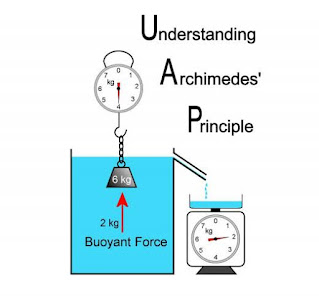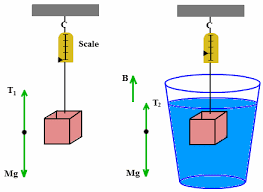ARCHIMEDES PRINCIPLES
There are lot of application of this principle in our daily life. Some application are list below:

1). The floatation of boat and ships on the surface of water.
2). Upward motion of air bubbles in the water.
3). Sudden upthrust in a mug when it is dipped perpendicularly in the water.
4). Not sinking of a air filled balloon if it is dipped in the water , and many more application can be found if we start searching in our surroundings.
So, question is what Archimedes principle states?
If we talk about it then Archimedes principle simply states that if a object is immersed fully or partially in the fluid (liquid or gas) then it suffer a upward buoyant force, that is equal the weight of the fluid which object displaced. This concept is given by a Greek philosopher Archimedes in 250 BCE

A SIMPLIFIED EXPLAINATION
When a object is immersed fully or partially in the fluid then it is observed that it’s original weight gets reduced. Then Archimedes thought that somewhere fluid is applying a upward force that opposes object gravitational weight. Then Archimedes perform a experiment to find the magnitude of upward force. He take a bucket and filled it to its brim with water, then he submerged a spherical hollow ball into it , then he noticed that some amount of water fell down from the bucket, then he measures the volume of displaced water or fallen water and he find its weight, then he find the upward force by multiplying it by acceleration due to gravity, which is acting on the ball.
After calculating all , then he finds that the upward force in the ball is equal to the weight of the displaced water. And his upward force or upthrust is termed as buoyant force. After performing all these experiments he says that if a body is immersed fully or partially in the fluid then the volume of fluid displaced is equal to the volume of the object, and the weight of the volume displaced is equal to the buoyant force which act as the upthrust and used to opposes the gravitational pull and give a upward motion.
Thus, the net force on the object is the difference between the magnitude of buoyant force and it’s gravitational weight.
If this difference is positive then then buoyant force become dominant and object rises up. If this difference is negative then gravitational weight become dominant and then object start sinking. If this difference gives zero then object neither rises nor sink , means object become static at that position. And Archimedes also observed that due to buoyant force object experience a apparent weight loss which is equal to the weight of the displaced fluid, when an object are used to be sink fully or partially in the fluid.
Some mathematical operations

Let’s take a spherical ball of density ρ and radius R , and a fluid of density σ
Then the volume of the sphere is = (4/3)πR^3
And weight of the ball is = Mg = Vρg
= (4/3)πR^3ρg
And weight of the displaced fluid is= (4/3)πR^3σg = Vσg = buoyant force
If ;
Buoyant force > gravitational weight = rises up.
Buoyant force
Buoyant force = gravitational force = static
Neither sink nor rise, remains at same position.